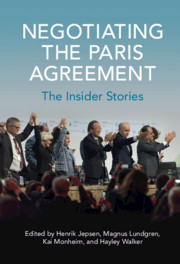Book contents
- Negotiating the Paris Agreement
- Negotiating the Paris Agreement
- Copyright page
- Contents
- Figure
- Editors
- Contributors
- Acknowledgments
- Foreword
- 1 Introduction
- 2 The Paris Negotiations: Background and Context
- 3 The French COP 21 Presidency
- 4 Mission: Adoption with Ovations: The Contribution of the UNFCCC Secretariat to the Achievement of the Paris Agreement
- 5 The Paris Agreement and China’s Imprint
- 6 The EU’s Role in the Paris Agreement
- 7 The United States: Interesting Processes and Techniques Lined the Road to Paris
- 8 COP 21 – Complaints and Negotiation: The Role of the Like-Minded Developing Countries Group (LMDC) and the Paris Agreement
- 9 The Staircase of Paris
- 10 The Battle for Small Island Developing States
- 11 The High Ambition Coalition
- 12 The Power of Civil Society
- 13 Business: Creating the Context
- 14 Why Did They Finally Reach Agreement?
- 15 Conclusion: The Landscape of Multilateral Agreement in Paris and Beyond
- Afterword
- Appendix: The Paris Agreement
- References
- Index
6 - The EU’s Role in the Paris Agreement
Published online by Cambridge University Press: 24 September 2021
- Negotiating the Paris Agreement
- Negotiating the Paris Agreement
- Copyright page
- Contents
- Figure
- Editors
- Contributors
- Acknowledgments
- Foreword
- 1 Introduction
- 2 The Paris Negotiations: Background and Context
- 3 The French COP 21 Presidency
- 4 Mission: Adoption with Ovations: The Contribution of the UNFCCC Secretariat to the Achievement of the Paris Agreement
- 5 The Paris Agreement and China’s Imprint
- 6 The EU’s Role in the Paris Agreement
- 7 The United States: Interesting Processes and Techniques Lined the Road to Paris
- 8 COP 21 – Complaints and Negotiation: The Role of the Like-Minded Developing Countries Group (LMDC) and the Paris Agreement
- 9 The Staircase of Paris
- 10 The Battle for Small Island Developing States
- 11 The High Ambition Coalition
- 12 The Power of Civil Society
- 13 Business: Creating the Context
- 14 Why Did They Finally Reach Agreement?
- 15 Conclusion: The Landscape of Multilateral Agreement in Paris and Beyond
- Afterword
- Appendix: The Paris Agreement
- References
- Index
Summary
Susan Biniaz, lead US climate lawyer from 1989 to 2017, provides an analysis of the role and perspective of the United States. According to Biniaz, US policy toward an international agreement on climate change was guided by four primary objectives: it should apply to developing countries, incorporate self-determined mitigation commitments, reflect a balance between binding and non-binding provisions, and include strong mechanisms for reporting and review. The chapter traces how the United States sought to promote these objectives in the years leading up to Paris, identifying the Major Economies Forum as a key process to build trust and identify potential “landing zones”. Stronger US-China bilateral engagement played a crucial role. Biniaz shows how the shape of the negotiation table can matter and how informal “huddles” have played an important role. The chapter ends with a commentary by Jonathan Pershing, former US negotiator and Program Director at the World Resources Institute, which highlights the diplomacy and discussions, often behind the scenes, required to assess the credibility of proposed nationally determined contributions.
- Type
- Chapter
- Information
- Negotiating the Paris AgreementThe Insider Stories, pp. 111 - 138Publisher: Cambridge University PressPrint publication year: 2021
- 2
- Cited by

